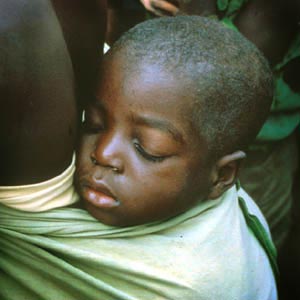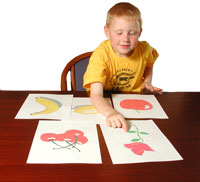
|
|
Visual Skills Used for Functional Vision
The visual skills used for functional vision are listed here in the order that they should be assessed. The order of the skills follows the sequence of normal visual development which have been outlined by Professor Natalie Barraga.
A person with low vision may not be able to progress through all the steps without special training. Some skills may not able to be achieved (for example tracking moving objects) but the person can still progress on to later steps. The assessment of functional vision has been based on the Low Vision Kit.The seven areas of skills to be assessed are explained and examples are given of how the skills are used. These visual skills are used to carry out everyday activities.
1. Awareness and attention to objects
Finding an object or target and looking at it (fixating) long enough to be aware of it or recognise it.Reason for assessment: Can a person see objects close to them? Does the person search for objects visually or with their hands? What makes objects easier or possible to be seen?
Factors that affect how easy an object is to find or recognise are:
- size
- distance
- contrast
- familiarity (makes it easier to recognise)
2. Control of eye movements - tracking
Being able to follow moving objects with the eyes or head movement.
Reason for assessment: Can the person follow the movement of objects without "losing" where they have gone?
Different directions of movements should be tested:
- up and down
- side to side
- diagonal and
- near to far
991KB
The movement might be people or animals running or something dropped on the ground and rolling away. Tracking is needed to follow the movements of traffic. Tracking people or objects (such as a ball) is needed to play many games.
3. Control of eye movements - scanning
Accurately moving eyes from one object to another.
Reason for assessment: Some people with low vision have to search around for a long time to find objects. Some may find it difficult to change from looking at near objects to look for something further away.
Searching the visual environment to look for a person or object requires scanning skills. An example is looking for a stall in a market.
4. Discrimination of objects
Recognition of objects from an outline or general shape.
Reason for assessment: To learn if a person can discriminate between people and objects, recognise familiar objects, recognise different or similar objects.
Objects can be discriminated because of their colour, shape, contrast, position or size- for example different foods in a market. The details within objects do not have to be seen. A person can see an object and move around it without tripping over or bumping into it. Large and small objects can give clues of how and where to move safely in the environment. Trees or doorways can help in finding where to go.
Finding objects in different situations. There may be confusing detail on or around the object or it may not contrast well against other objects. Finding an object against a background of other objects may be difficult. Good scanning and discrimination skills are needed.
Identification of objects. Differences and similarities have to be seen in objects to identify them. A bucket, basket and bowl all hold other objects such as food but they all look different and can be used for different purposes. Objects in the environment (trees, plants, animals) need to be discriminated and identified. How easy an object is to identify will depend on its size and distance, the type of object, how familiar it is, contrast with the background, colour and whether it is moving or still.
5. Discrimination of details to identify actions and match objects
The discrimination of detail to identify an object is more difficult than seeing the object. Features of the object have to be identified.
Reason for assessment: Most learning occurs from visual awareness and imitation. It is important to know what can be seen and how the environment (such as lighting) affects what can be seen. The factors of distance, size, colour and contrast are very important.
To interact with other people, vision provides valuable information to recognise people, and identify expressions and body gestures when no auditory clues (voices or noises) are available.
Matching objects. Objects may need to be discriminated or matched by size or shape. For example - get the largest stick or find a stick the same size.
6. Discrimination of details in picture
Gaining information from pictures. Pictures can be simple outlines or complex, detailed pictures. The important features (parts) in pictures have to be identified so that the meaning of the picture can be understood.
Reason for assessment: Pictures give useful information on posters, advertisements or in books. Objects in pictures may be difficult to find and recognise.
Identification of pictures. Pictures are used to give information and instructions such as on health education posters. They are easier to recognise if they look like the real object and have clear outlines. It is sometimes difficult to find an object in a picture when there is a lot of detail and many other objects in a picture.
7. Identification and perception of patterns, numbers and words
Matching letters and numbers by the similar or different features of them. This does not require reading but is a necessary skill for reading.
Reason for assessment: To find out if a person can discriminate between similar and different shapes and letters. The results will help in making decisions on whether a person should use normal size print, large print, low vision devices or may need Braille.
Many other patterns, letters or numbers can be used, in addition to the examples used in this book. Make sure that the shapes, letters or numbers are drawn or written with a dark pen on light coloured paper. Start using shapes that are very different so they are easy to discriminate. Discrimination is more difficult when the shapes are similar.
Recognition of words and matching them with pictures. Experience with simple words is a necessary skill in this item.
Checkpoint: Name the 7 areas of skills used to assess functional vision for children. For each area suggest a 'game' you could play that utilizes this skill
|
|
| Visual Communication Unit |

